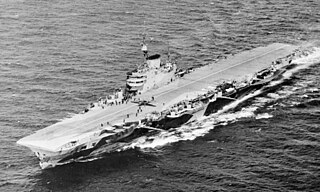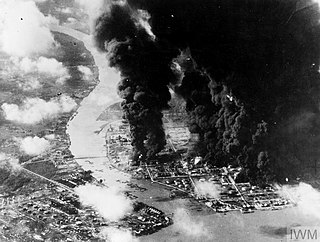Related Research Articles

HMS Indefatigable was one of two Implacable-class aircraft carrier built for the Royal Navy (RN) during World War II. Completed in 1944, her aircraft made several attacks that year against the German battleship Tirpitz, inflicting only light damage; they also raided targets in Norway. The ship was transferred to the British Pacific Fleet (BPF) at the end of the year and attacked Japanese-controlled oil refineries in Sumatra in January 1945 before joining the American forces in March as they prepared to invade the island of Okinawa in Operation Iceberg. Indefatigable and the BPF joined the Americans in attacking the Japanese Home Islands in July and August. Following the end of hostilities she visited ports in Australia, New Zealand and South Africa.

The British Pacific Fleet (BPF) was a Royal Navy formation that saw action against Japan during the Second World War. The fleet was composed of Commonwealth naval vessels. The BPF formally came into being on 22 November 1944 from the remaining ships of the former Eastern Fleet then being re-named the East Indies Fleet and continuing to be based in Trincomalee. The British Pacific Fleet's main base was at Sydney, Australia, with a forward base at Manus Island. One of the largest fleets ever assembled by the Royal Navy, by Victory over Japan Day it consisted of over two hundred ships and submarines and more than 750 aircraft; including four battleships and six fleet aircraft carriers, fifteen smaller aircraft carriers, eleven cruisers and numerous smaller warships, submarines, and support vessels. The fleet took part in the Battle of Okinawa and the final naval strikes on Japan.

Mobile Operational Naval Air Bases (MONABs) were a series of mobile units first formed in 1944 to provide logistical support to the Fleet Air Arm aircraft of the Royal Navy's British Pacific Fleet towards the end of World War II.

During World War II, Operation Meridian was part of a series of British air attacks directed at Japanese-held oil refineries on Sumatra. Meridian had two phases: Meridian One on 24 January 1945 and Meridian Two on 29 January. As a result, the critical aviation fuel output of the plants at Palembang was reduced by seventy-five percent.

HMS Nabbington, was a Royal Navy, Mobile Naval Operating Air Base (MONAB), that was established at the Royal Australian Air Force (RAAF) base RAAF Nowra at Nowra, New South Wales, in Australia during the final stages of the Second World War. HMS Nabbington was also known as MONAB I and Royal Naval Air Station (RNAS) Nowra.

HMS Nabberley was a Royal Navy Mobile Naval Operating Air Base (MONAB) at the Royal Australian Air Force (RAAF) base RAAF Bankstown at Bankstown, New South Wales, Australia. HMS Nabberley was also known as MONAB II and Royal Naval Air Station (RNAS) Bankstown.

RAAF Station Schofields is a former Royal Australian Air Force (RAAF) military air base and aerodrome located at Schofields, a suburb of Sydney in New South Wales, Australia. The aerodrome was used during World War II and was in operation between 1942 and 1944.
812 Naval Air Squadron was a Naval Air Squadron of the British Royal Navy's Fleet Air Arm. It was active between 1933 and 1956, and saw service in both the World War II and the Korean War.
This article provides an order of battle for the Allied forces involved in the Operation Mascot attack on the German battleship Tirpitz on 17 July 1944.

706 Naval Air Squadron was a Naval Air Squadron of the Royal Navy's Fleet Air Arm. Established as a fighter and torpedo-bomber training unit in Australia at the end of World War Two, it was briefly reformed as a helicopter squadron in the early 1950s, before becoming a helicopter training unit in 1962, and operating until 1998.

Operation Goodwood was a series of British carrier air raids conducted against the German battleship Tirpitz at her anchorage in Kaafjord in occupied Norway during late August 1944. It was the last of several attacks made by the Home Fleet during 1944 which sought to damage or sink Tirpitz and thereby eliminate the threat it posed to Allied shipping. Previous raids on Kaafjord conducted by Fleet Air Arm aircraft had involved only one air attack; in Operation Goodwood several attacks were made in a single week. The Royal Navy hoped that these raids would wear down the formidable German defences.

885 Naval Air Squadron was a Naval Air Squadron of the Royal Navy's Fleet Air Arm. First formed on 1 March 1941, the squadron served as a fighter squadron during the Second World War. It operated in the Mediterranean in 1942–43, where it took part in Operation Torch, the Anglo-American invasion of French North Africa, the Allied invasion of Sicily and the Allied invasion of Italy. In 1944 it took part in the Allied invasion of Normandy, spotting for Allied artillery bombardments and in 1945, was deployed as part of the British Pacific Fleet. It was abolished for the last time on 27 September 1945.
887 Naval Air Squadron was a Naval Air Squadron of the Royal Navy's Fleet Air Arm.
Sub-lieutenant Victor Soutar Lowden DSC was a Scottish businessman and Royal Navy Fleet Air Arm fighter pilot during World War II. On 15 August 1945 he flew as fighter escort with one of the last Allied bombing raids on Tokyo Bay, subsequently participating in the last dogfight of the war, for which he was honoured.

715 Naval Air Squadron was a Naval Air Squadron of the Royal Navy Fleet Air Arm created on 15 July 1936 to serve as a Catapult Flight of the Fleet Air Arm of the RAF. It was elevated to Squadron status at the end of 1937, before being disbanded on 21 January 1940. It was re-formed on 17 August 1944 to operate as the Fighter Wing of the School of Air Combat, before being disbanded for good on 31 March 1946, and absorbed into 736 Naval Air Squadron.

718 Naval Air Squadron was a Naval Air Squadron of the Royal Navy created on 15 July 1936 to serve as a Catapult Flight of the Fleet Air Arm. It was elevated to squadron status at the end of 1937, before being disbanded on 21 January 1940. It was re-formed on 5 June 1944 to operate as the Army Co-operation Naval Operational Training Unit before being disbanded again on 1 November 1945. On 23 August 1946 it was reformed for the third time to operate as a Seafire Conversion Squadron but was disbanded less than one year later, on 17 March 1947. On 25 April 1955, after almost a decade, the squadron was reformed once more to train RNVR on jet aircraft. Once this work was complete, it was disbanded for the final time on 31 December 1955.

777 Naval Air Squadron was a Fleet Requirements Unit which was formed in West Africa during the Second World War.
1770 Naval Air Squadron was a Naval Air Squadron of the Royal Navy's Fleet Air Arm. It formed at RNAS Yeovilton on 10 September 1943 as a two-seat fighter squadron and embarked on HMS Indefatigable in May 1944. It took part in several attacks on the German Battleship Tirpitz and other operations in Norwegian waters before sailing for the Far East. In 1945, as part of the British Pacific Fleet, the squadron took part in attacks on Sumatra, Sakishima Gunto and Formosa. It disembarked to Australia in June 1945 and then disbanded on 30 September 1945 at RAAF Maryborough.
1843 Naval Air Squadron was a Naval Air Squadron of the Royal Navy's Fleet Air Arm.
References
- "The MONAB Story". Archived from the original on 20 July 2012.